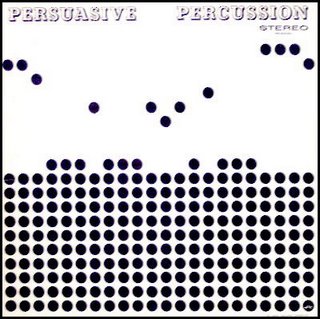Demanding Command: Terry Snyder's "Persuasive Percussion"

PERSUASIVE PERCUSSION
TERRY SNYDER AND THE ALL STARS
COMMAND RS 800 SD
This is, of course, one of the best selling and most influential albums released in during the early years of stereo. The concept of the Command label was the brainchild of Enoch Light, who had already been dabbling with stereo recording on the Grand Award label. This initial Command release from 1959, was a favored disc in the Hi-Fi world for demonstrating stereophonic sound to the masses
Command releases were unusual in many ways. The distinctive artwork that graced the first four releases was created by noted artist and author Josef Albers. The bold minimalist graphic style of the Albers covers. After that, Command's art director took over the task, and carried the theme (more or less) throughout the series. The jackets were heavy duty laminated gatefold type, which were unheard of at the time. Indeed, while the artwork on most LPs from the era has faded, the vibrant Command jackets look as good today as they did when released
Another innovation was the listing of complete technical information, such as the type of recording tape used, the microphone selection, and the monitoring, mastering and plating equipment used in the disc's production. There was usually a diagram of the orchestral layout and a track by track analysis on the sound and arrangement, image placement and dynamic range along with descriptions of the various instruments being employed. Clearly this was aimed at the Hi-Fi enthusiasts, who are today known as audiophiles
The set contains twelve instrumental standards such as "I Love Paris", "Tabu", "My Heart Belongs to Daddy" and "The Breeze and I". Not exactly reveloutionary stuff. The difference here is that tese tunes were specifically arranged to take advantage of the spacial effect of stereo. The separation is remarkable, although a purist's soundstage it is not. Instruments may move from left to right on occasion (mostly at the beginnining of a track for channel identification ). The recording is up-close and detailed, with incredible dynamic range. The percussion spices up the arrangements, and is ideal for demonstrating the stereophonic effect. The result is a lightweight yet thoroughly entertaining listen.
I've got two copies of this record: One is the first label (gray and white) and the other is the second label issue (gold and white). The original is a beautifully pressed disc from RCA's Indianapolis plant; thick vinyl, quiet surfaces and excellent dynamic range. Suprisingly, the gold label disc was it's equal in sound.
Persuasive Percussion is certainly some kind of classic, a milestone in stereophonic reproduction, that deserves a prime spot in any collection of early stereo records. Highly recommended!


No comments:
Post a Comment